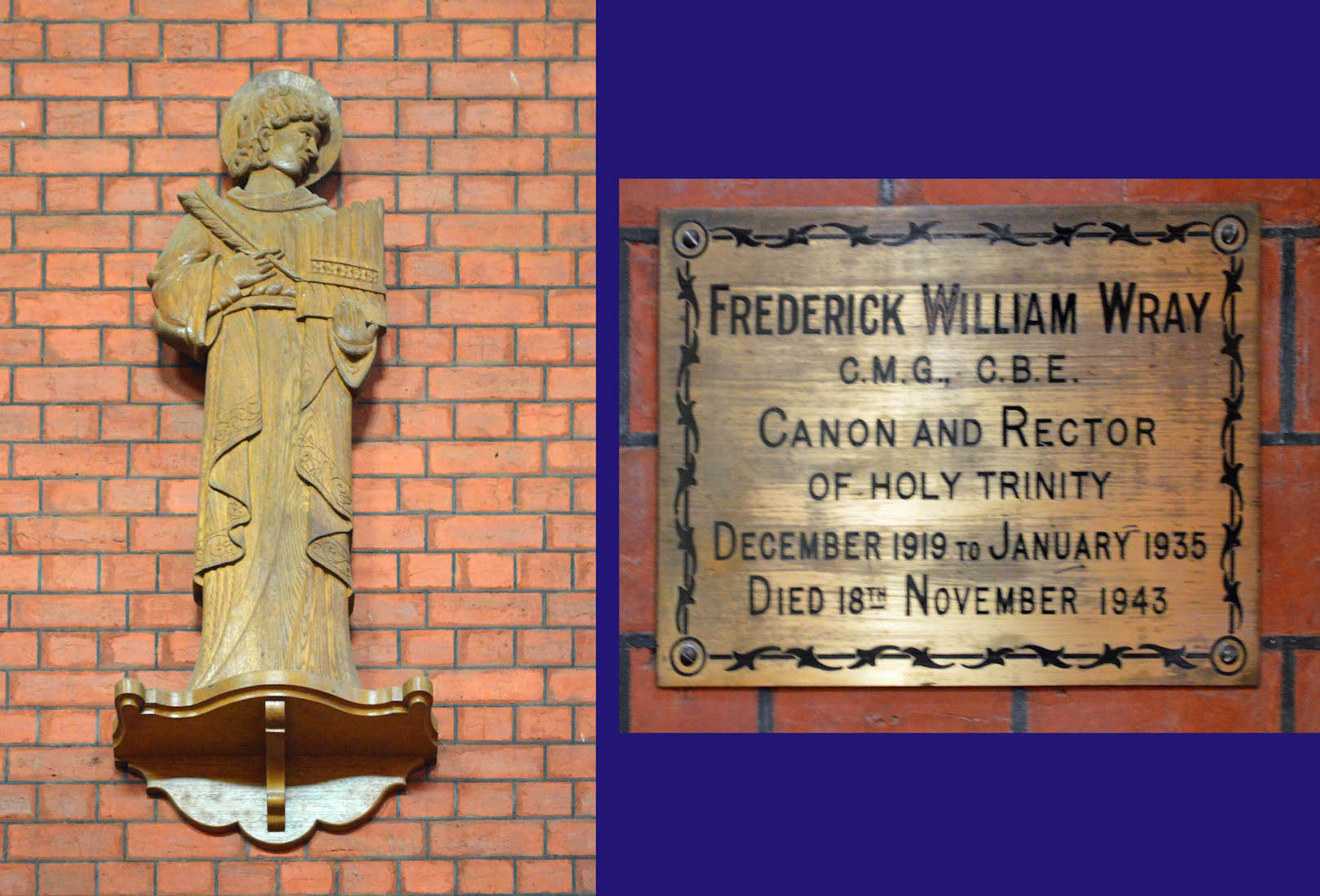
On the opposite column are two plaques. The first is in memory of Frederick Charles Purbrick, an actively contributing member of the Cathedral for many years. The small plaque attributes the St Columba clerestory window to the memory of the Rev Palmer Law. INDEX
42. PULPIT AND CRUCIFIX

The solid marble pulpit was given in memory of Bishop Thomas Henry Armstrong who died in 1930. On the wall behind the pulpit is this crucifix. Above the Christ figure is the inscription ‘INRI’, standing for ‘Jesus Christ, King of the Jews’. The memorial plaque is at the base of the crucifix.
44. ORGAN
The organ is a Lewis and Willis instrument dating from 1922, originally built for the First Church of Christ Scientist in Rathmines, Dublin. The brass plaque by the organ lists donations from various people towards the organ and music of the Cathedral.
45. ORGAN CONSOLE
The organ has three manuals, and the instrument incorporates the casework and spotted metal façade pipes from a previous organ installed here.
46. CHANCEL CEILING
The ceiling of the chancel exhibits some fine workmanship. Timber planks in a light shade are supported by a dark framework, decorated in part by crossed struts and bosses.
47. ROSE WINDOW
This small rose window is situated in the gable of the East wall. This window is probably the work of Brooks Robinson, a firm that produced much of its best work around 1920.
48. CRUCIFIX
The blue and yellow curtain provides a dramatic background to this crucifix on the East wall. It shows Christ as the High Priest, reigning from the cross, and is the creation of Leopoldine Mimovich, a distinguished wood carver from Italy.
49. HIGH ALTAR
The high altar stands before the crucifix on the East wall. It is here that the Eucharist is celebrated Sunday by Sunday.
50. SEDILIA
In the sanctuary we find these seats used by the officiating clergy. Of course, they are described by their Latin name!
51. PLAQUE AND CANDLESTICK
The brass plate tells that the Sanctuary and Chancel were built as a memorial to Francis Heach who bequeathed the money for them to be built. The large candlestick is one of a pair which stand on either side of the High Altar.
52. SOUTH CHANCEL
We now turn our attention to the South side of the Sanctuary and Chancel. The three curtained arches lead through to the Lady Chapel.
53. CATHEDRA
The finely carved Bishop’s Throne is called ‘cathedra’ in Latin. This Church is called a Cathedral because the Bishop’s Throne is sited here. On the back of the cathedra is the coat of arms of the Diocese of Wangaratta. It shows a Bishop’s mitre above a shield bearing the image of two stalks of grain and a bunch of grapes – signifying bread and wine.
54. ST CECILIA AND PLAQUE
Above the choir stalls on the South side of the chancel is a relief woodcarving of St Cecilia, the patron saint of music. Nearby on this wall is a small plaque commemorating Frederick William Wray who was Canon and Rector of Holy Trinity from 1919 to 1935.
55. CROSSING
We leave the Chancel and return to the Crossing – at least this is where the Crossing would be, if there were a transept! The doorway on this South side leads through to the Lady Chapel.
56. LECTERN
The design of the lectern is quite different from that of the pulpit, but the two are complementary. It is from here that the Scripture is read on a Sunday. It is traditional in Anglican churches for the Bible to be borne on the wings of an eagle. This is a particularly attractive wooden eagle.
57. HONOUR ROLL
Looking down the South aisle of the nave we see this Honour Roll listing the names of those of this Parish who gave their lives in the Great War of 1914 –1918.
58. CARVED MADONNA
Close to the entrance of the Lady Chapel stands this unusual wood carving by the Bavarian Hans Knorr (1915 – 1987). Knorr shows the Virgin as a mother sheltering her infant as He clings to her, with his back to the world. Near the Madonna is this inscription, reminding us that the Cathedral is a place for pausing and reflecting on our life before God.
60. CHAPEL ALTAR
The front of the Lady Chapel is simply furnished with altar, candlesticks and painting.



















